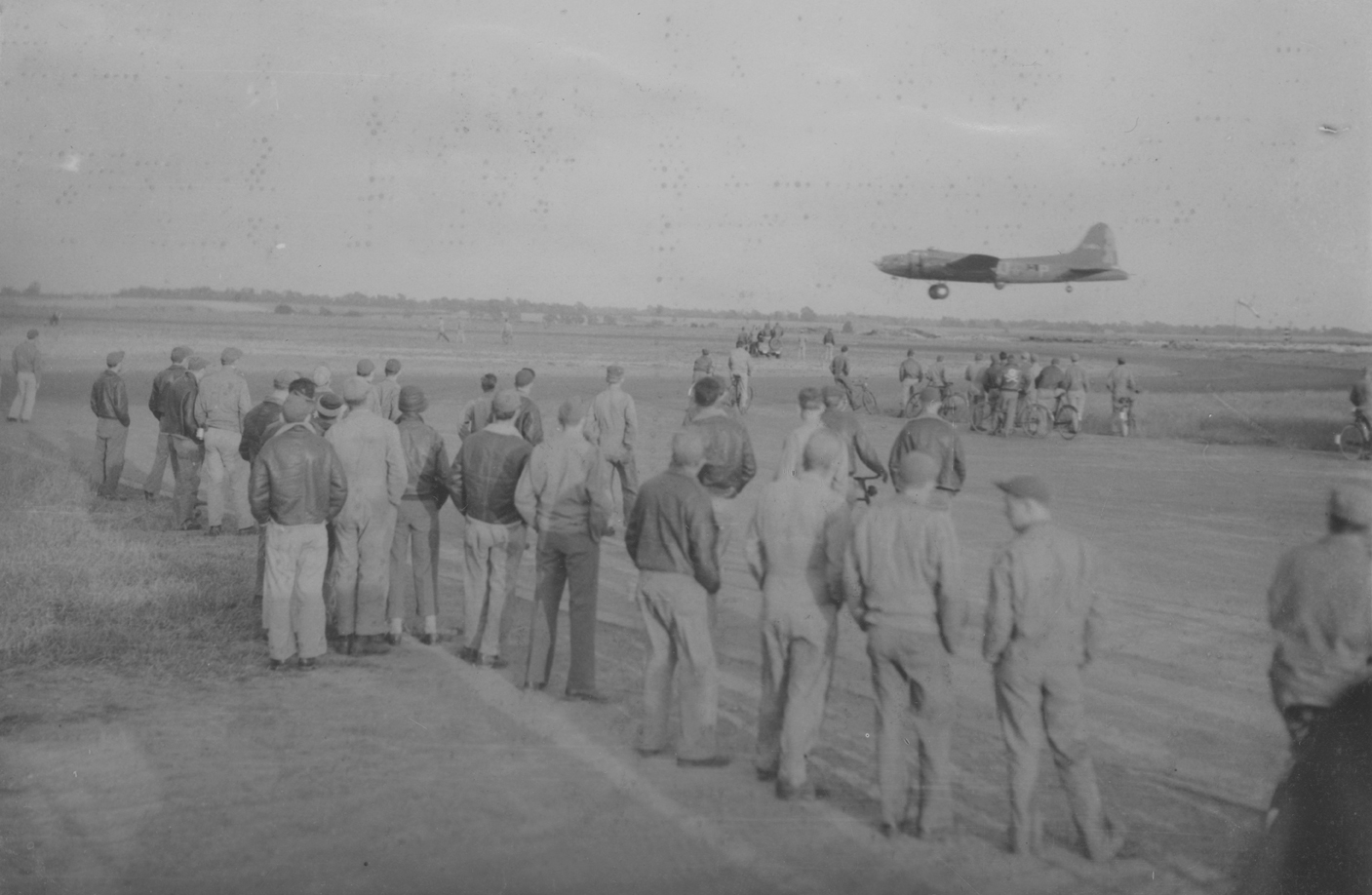Chelveston
Airfield
IWM, Roger Freeman Collection
Object Number - FRE 10410 - Ground crews of 305th Bomb Group B-17 Flying Fortresses wait for their aircraft to return to Chelveston airbase after a raid on the 30 June 1943; a...
Chelveston was adapted and expanded in preparation for the arrival of American forces. Rather than heavy bombers, the first aircraft to fly from its runways were C-47 Skytrains that were flown by the 60th Troop Carrier Group in July 1942. The first combat group posted to Chelveston were the 301st Bomb Group who flew a handful of missions before moving to North Africa with the Twelfth Air Force in the aftermath of Operation Torch. The next Bomb Group to fly from the base were the 305th, another B-17 Group. The Group flew 330 missions from here and, as one of the first B-17 Groups to fly in the ETO, it was from here that some of the pioneering techniques and formations were developed.
Connections
See how this entry relates to other items in the archive by exploring the connections below.
People
- Military/Civilian/Mascot: Military
- Nationality: American
- Unit: 305th Bomb Group 422nd Bomb Squadron
- Service Numbers: 11138368
- Highest Rank: Sergeant
- Role/Job: Top Turret Gunner
- Military/Civilian/Mascot: Military
- Nationality: American
- Unit: 305th Bomb Group 366th Bomb Squadron
- Highest Rank: Staff Sergeant
- Role/Job: waist gunner
- Military/Civilian/Mascot: Military
- Nationality: American
- Unit: 305th Bomb Group 366th Bomb Squadron
- Highest Rank: Staff Sergeant
- Role/Job: waist gunner
- Military/Civilian/Mascot: Military
- Nationality: American
- Unit: 305th Bomb Group 364th Bomb Squadron
- Highest Rank: Technical Sergeant
- Role/Job: Top Turret Gunner
- Military/Civilian/Mascot: Military
- Nationality: American
- Unit: 305th Bomb Group 366th Bomb Squadron
- Service Numbers: 17160789
- Highest Rank: Staff Sergeant
- Role/Job: Ball Turret Gunner
Aircraft
- Aircraft Type: B-17 Flying Fortress
- Nicknames: Doc Stork
- Aircraft Type: B-17 Flying Fortress

- Aircraft Type: B-17 Flying Fortress
- Aircraft Type: B-17 Flying Fortress
![King George VI passes a B-17 Flying Fortress (serial number 41-24352) nicknamed "Holey Joe" as he meets personnel of the 301st Bomb Group during a royal visit. Image stamped on reverse: 'Copyright Central Press Photos Ltd.' [stamp], 'Passed for Publication 13 Nov 1942.' [stamp], 'P (KING) CCC(USA).'[written annotation] and '232594.' [Censor no.] A printed caption was previously attached to the reverse of the image however this has been removed. Handwritten caption on reverse: '301 , 124352?, Alconbury?.'](https://assets.americanairmuseum.com/s3fs-public/styles/max_650x650/public/freeman/media-378791.jpg?itok=qRqg3Dxb)
- Aircraft Type: B-17 Flying Fortress
- Nicknames: Holey Joe
- Unit: 301st Bomb Group 352nd Bomb Squadron
Revisions
Merged with duplicate entry to include details from:
- user Despitz
Barry Anderson, Army Air Forces Stations (Alabama, 1985) / Roger Freeman, Airfields of the Eighth Then And Now (London, 1978)


![A 305th Bomb Group B-17 Flying Fortress takes off from Chelveston airbase to go on a raid. Passed for publication 30 Jun 1943. Printed caption on reverse: 'At A Fortress Station In Britain. From an American base in Britain the Flying Fortresses carry out operational activities which result in terrible blows against the German industrial war machine. This series of pictures shows scenes at a Flying Fortresses station where hige[sic] bombers take off for the raids or return from their missions to be service](https://assets.americanairmuseum.com/s3fs-public/styles/max_650x650/public/freeman/media-458162.jpg?itok=6rpDaXQs)
![B-17 Flying Fortresses of the 305th Bomb Group line up for take off at Chelveston. On reverse: Keystone Press and [damaged] US Army Press Censor [Stamps]. Printed caption on reverse: 'At A Fortress Station In Britain. From an American base in Britain the Flying Fortresses carry out operational activities which result in terrible blows against the German industrial war machine. This series of pictures shows scenes at a Flying Fortresses station where hige[sic] bombers take off for the raids or return from](https://assets.americanairmuseum.com/s3fs-public/styles/max_650x650/public/freeman/media-458115.jpg?itok=kAQOxQ0I)

![305th Bomb Group B-17 Flying Fortress prepare to take off from Chelveston airbase to go on a raid. Passed for publication 30 Jun 1943. Printed caption on reverse: 'At A Fortress Station In Britain. From an American base in Britain the Flying Fortresses carry out operational activities which result in terrible blows against the German industrial war machine. This series of pictures shows scenes at a Flying Fortresses station where hige[sic] bombers take off for the raids or return from their missions to be](https://assets.americanairmuseum.com/s3fs-public/styles/max_650x650/public/freeman/media-458116.jpg?itok=3GhjdzU9)
![Ground crews of 305th Bomb Group B-17 Flying Fortresses play cards to pass the time until their aircraft return to Chelveston airbase. Passed for publication 30 Jun 1943. Printed caption on reverse: 'At A Fortress Station In Britain. From an American base in Britain the Flying Fortresses carry out operational activities which result in terrible blows against the German industrial war machine. This series of pictures shows scenes at a Flying Fortresses station where hige[sic] bombers take off for the raids](https://assets.americanairmuseum.com/s3fs-public/styles/max_650x650/public/freeman/media-458183.jpg?itok=c3ELYCx-)



